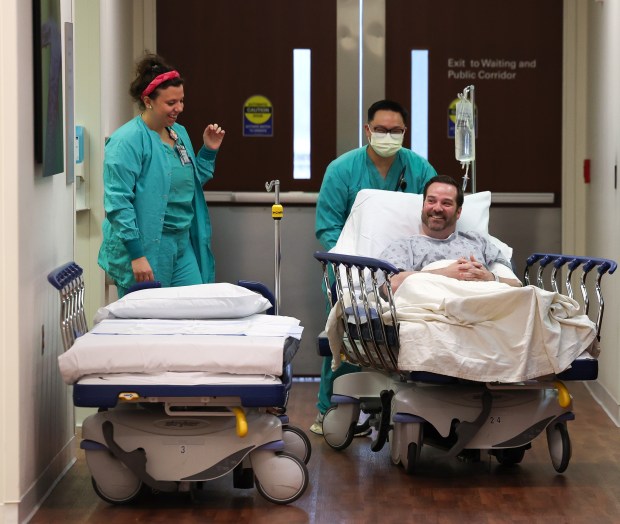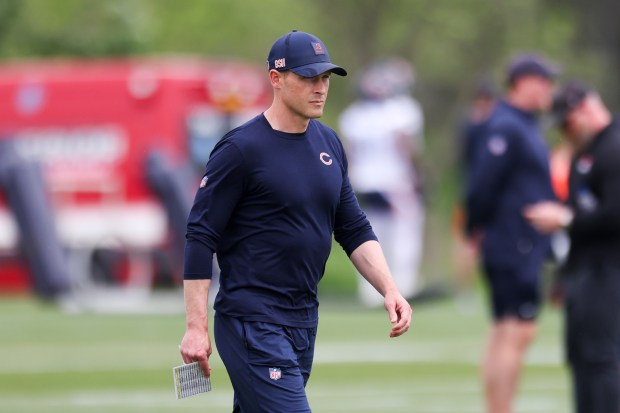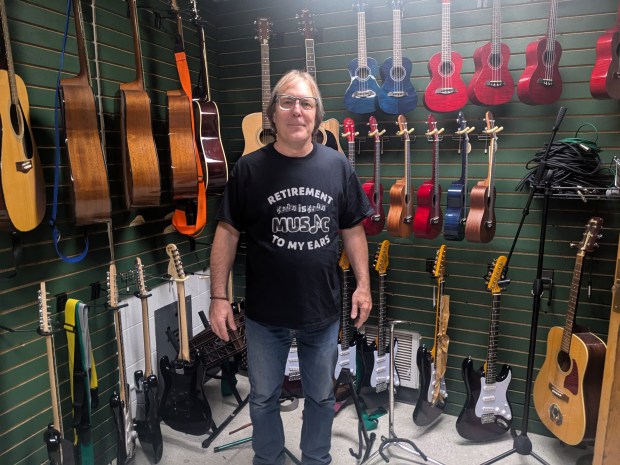Almost exactly a year after he was diagnosed with colorectal cancer, WGN-TV reporter Mike Lowe’s cell phone pinged as he drove to work early last week.
It was a message from his doctor — the results of his latest colonoscopy, a test meant to show whether six weeks of radiation and four months of chemotherapy had worked. The results were exactly what he had hoped to see: The cancer was no longer detectable.
“Getting those results, it was just the most amazing feeling,” Lowe said. “I think back to one year ago, when I went to the initial doctor’s appointment … .In some ways it feels like forever and in some ways it feels like the blink of an eye — but what a year.”
It was a year that started with surprise at his diagnosis at the age of 44. Lowe’s surprise, however, quickly turned into a conviction that he would use his platform as a television news reporter to raise awareness about the disease, which has increasingly been striking people at younger ages. For the past year, he’s taken WGN viewers along on his journey, talking about his diagnosis in news segments, inviting cameras into his appointments and procedures and sharing very personal details about his experience.
“It is a public health crisis in this country where younger and younger people are being diagnosed with colorectal cancer,” Lowe said.
About 20% of colorectal cases were in people ages 54 or younger in 2019 — almost double the percentage as in 1995, according to the American Cancer Society. Scientists aren’t sure exactly what’s causing the increase in diagnoses among younger patients, but they’re urging people to see their doctors if they experience unusual symptoms such as abdominal pain, changes in bowel habits, diarrhea, bloody stools or constipation.
Colorectal cancer is the fourth-most common type of cancer in the U.S., according to the National Cancer Institute at the National Institutes of Health.
As a journalist, Lowe felt it was his duty to share his experience with viewers.
“It’s my job to ask people about some of the worst experiences they have in their lives and be open and honest about it,” said Lowe, who’s won 39 Emmy Awards. “How I could do that for a living, and then when something like this happens to me, not be open and honest with the public about my own story?”
Lowe, who grew up in Evanston, knew he wanted to be a journalist from an early age. He attended Northwestern University before taking a series of broadcast jobs across the country. He earned a spot at WGN about a decade ago.
Lowe is a “born storyteller,” said Dominick Stasi, news director at WGN-TV.
“He’s probably the best storyteller that I’ve ever worked with, and when it came time for this journey that he was going on … he saw this as a way for him to tell his story and also educate people,” Stasi said.
The diagnosis
Though Lowe was diagnosed with cancer about a year ago, he now realizes that the disease had been building for years.
About five years ago, Lowe began experiencing concerning symptoms, such as blood in his bowel movements. He knew he had a family history of the illness, because his grandfather had colon cancer. Lowe went to his general practitioner at the time, who recommended a colonoscopy.
“I fumbled the ball,” said Lowe, a huge Chicago sports fan. “She gave me the referral and I just never made the appointment.
“I think that’s indicative of especially a lot of young men who are apprehensive about a colonoscopy,” Lowe said, adding that, “I guess you’re also worried about what they might find.”
A couple of years later, he had a new doctor. He told the new doctor he was ready to get the colonoscopy and asked for another referral. That doctor, however, told him he’d get a colonoscopy when he was 45, Lowe said. The U.S. Preventative Services Task Force lowered the age at which it recommends most patients be regularly screened for colorectal cancer from 50 to 45 in 2021, partly in response to more younger people developing the disease.
Lowe moved on. He was still having some constipation and a little abdominal pain, but he was an otherwise healthy guy in his early 40s. He did triathlons and was known among friends and colleagues for his energy, humor and positivity. He jokes now that he thought, at the time, that maybe he just needed to lay off the Mexican fast food and eat more kale salads.
But by February of last year, he could no longer ignore his escalating symptoms. He had blood in every bowel movement and felt like he couldn’t empty his bowels all the way. One night he ended up in an emergency room with stabbing abdominal pain. He waited for a few hours but started feeling better and left without being seen.
When he told his mom about the episode, she was alarmed and insisted he make an appointment with his doctor — in front of her. She watched as he sent a message over his phone.
Lowe got an appointment, and the doctor did a rectal exam. Almost immediately, he was fairly sure that Lowe had cancer. A colonoscopy soon confirmed the doctor’s suspicion. Lowe had stage 3 colorectal cancer. The cancer had spread to nearby lymph nodes, but not yet to other organs.
“I’ll always have in the back of my mind, ‘Man, I wonder if I had had a colonoscopy back then if we would have caught this as a polyp instead of stage 3 cancer,’” Lowe said of his earlier visits to doctors. “What I later learned is you really have to advocate for yourself if you think there’s something wrong.”
Sharing his battle
At that point, Lowe faced a winding path of medical appointments, treatments and side effects.
First, he started with radiation. He had about 30 rounds of radiation treatments over six weeks. The worst side effects, he said, were fatigue toward the end and a burning sensation during urination. “Radiation is a lot easier on the body today than it was 20 or 30 years ago,” Lowe said.
Also making radiation a little easier was the patient in line before him each day: famed former Cubs player Ryne Sandberg, who has been battling prostate cancer. As a child, Lowe had a poster of Sandberg on his bedroom wall.
The two ended up spending a lot of time together, talking about everything from radiation side effects to the Rolling Stones.
“It was unbelievable to me because he was one of my childhood heroes,” Lowe said. “To see one of your heroes like that, in that context, it was surreal.”

Lowe would get radiation treatments early in the morning and then head to work.
“There were certain setbacks, but he just tackled each and every one of them and wanted to keep working as much as he could,” said Stasi of WGN. “He approached the whole thing with a positive attitude. It was really kind of inspiring.”
Lowe also continued working through his chemotherapy, which took a heavier toll on him than radiation. The side effects of chemotherapy intensified as the weeks went on. He experienced nausea, numbness in his hands and feet, and the skin on his feet and palms peeled.
At one point, he developed sores in his mouth and throat, as part of a condition called mucositis, which he described as akin to the worst case of strep throat he’s ever had — times two. He detailed his ordeal with mucositis, which happened while he was on a pre-planned vacation from work, in a segment on WGN, describing how he couldn’t swallow or sleep for six days.
But, in general, the side effects never got so bad that he needed to take a medical leave from work. Rather, he went to work most days, sometimes wearing a small zippered pouch across his chest that contained chemotherapy medication, which traveled via a tube from the bag to a port in his chest.
“I wanted cancer to be something important that was going on in the background of my life but not completely dominating it,” Lowe said. “If I could have a real purpose and go to work and feel like I was able to do it and do it well still, then I was going to do it no matter what.”
Lowe believes that he may have been able to keep working through cancer treatments partly because he was relatively young and healthy going into them.
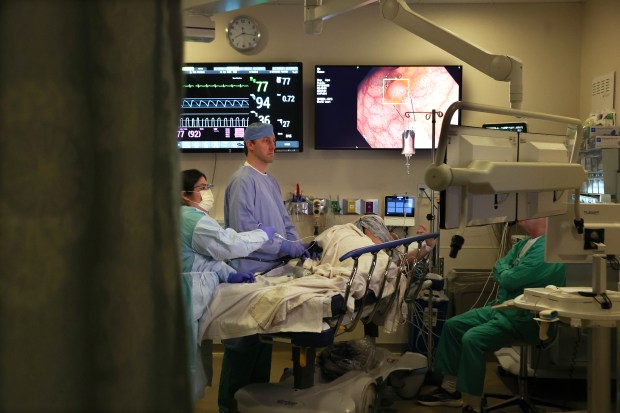
During the Democratic National Convention in Chicago in August he did live shots each night from the United Center. He worked election night in November and then allowed WGN’s cameras to follow him to Northwestern Medicine Lake Forest Hospital for chemotherapy the next morning.
“I wanted to kind of demystify cancer treatment or show exactly what it looks like,” Lowe said. “If you can help anybody understand what they’re about to go through, I think that helps, and the position of a journalist is to do that, to explain things and make them more understandable.”
Dr. Daniel Dammrich, one of Lowe’s doctors and an oncologist at Northwestern’s Lake Forest hospital, said he’s already seen people benefiting from Lowe’s news segments, getting screened for cancer earlier than they might have otherwise.
Decades ago, before Lowe and Dammrich were patient and doctor, they were teenage football teammates at Loyola Academy in Wilmette.
“He’s just always been a great guy,” Dammrich said. “Mike has been extraordinarily brave to share his story, and there’s no doubt in my mind that it’s going to benefit a huge amount of people who are going to go for early colorectal cancer screenings so they can catch it in a time where we can intervene in a meaningful way.”
‘Keep up the fight!’
Throughout his treatment, Lowe received support from many unexpected quarters.
Shortly after hearing about Lowe’s diagnosis, Joe Johnson, founder of Obvious Shirts, released a T-shirt that said “Lowe Strong” with a similar design to the Bears sweaters coach Mike Ditka used to wear. Lowe had done stories on Johnson and Obvious Shirts in the past.
“If you know Mike, you know he’s a huge Bears fan, a diehard Bears fan, so I thought it was only right we show our support,” Johnson said.
At one point, Gov. JB Pritzker sent Lowe a handwritten note expressing support and encouraging him to, “Keep up the fight!”
“I have really felt the outpouring of support from really the entire city,” Lowe said. “I think that’s kind of a hallmark of Chicago. … You see how much you’re loved and you see how much people care and want to help. That is almost as important as the medical part, in terms of making you well again.”
Then, in January, after chemotherapy, Lowe underwent an MRI and had a sigmoidoscopy, a procedure that involves using a camera to look at the lower part of the colon. If the tumor was still there, the next step would be surgery.
Lowe got tentatively good news. The doctor couldn’t see the tumor anymore.
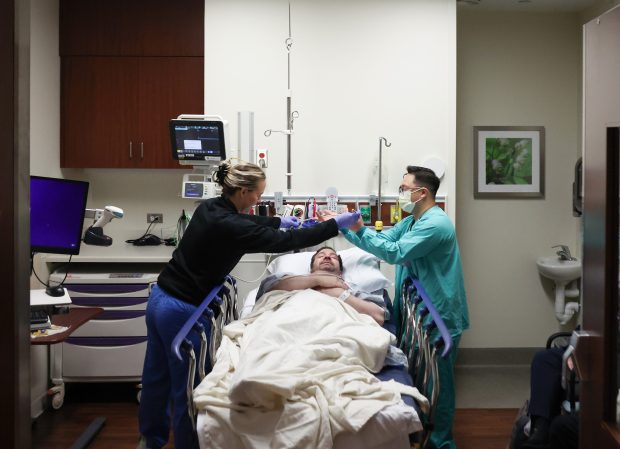
Lowe was optimistic about his prospects, but he would need a colonoscopy and biopsies months later to see if the cancer had really retreated.
That colonoscopy happened earlier this month. Biopsies were performed on polyps found during the procedure, and they came back clear of cancer.
“It was kind of like singing Hallelujah from the church balcony,” Lowe said of learning the results. “It definitely felt amazing because up until that point I didn’t know …I feel like it’s the complete response I’d been hoping against hope for.”
Though Lowe is characteristically optimistic, he knows he won’t be leaving cancer totally behind him just yet.
He’ll continue to undergo regular tests to ensure the cancer hasn’t returned. He’s also still dealing with lingering side effects, such as the numbness in his hands and feet.
Lowe also has no plans to step back from the public stage when it comes to discussing his experience. He has a calendar full of events in coming months where he’ll give speeches and emcee events to raise awareness and money for various cancer-related efforts.
“I feel like I owe it to anyone who’s dealing with cancer, if I can be the voice, whether it’s for fundraising, awareness or even if it’s just to comfort them, to show them, ‘Hey you can get through this,’ because at the time you get the diagnosis, it doesn’t always seem like that. It seems like a pretty steep hill to climb,” Lowe said.
“If I can continue to be that example to anyone, I want to continue to do that because I know how lucky I am to be through it.”


